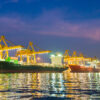

How long does it take to build a container? The short answer is: The time is insignificant, a matter of hours including the automated process of putting the steel walls together and drying the paint.
Containers are built at highly efficient and highly automated factories, virtually all of which are in China. Eight out of every 10 containers built worldwide are produced by just three Chinese companies: CIMC, Dong Fang and CXIC.
One indicator of just how quickly new boxes can be popped out: China’s factories can theoretically work around the clock and add a second 12-hour shift, but haven’t done so despite this year’s historic demand. One reason they’ve kept to one shift (besides propping up container prices) involves customer preference.
During an interview with American Shipper in May, John Fossey, Drewry’s head of container equipment and leasing research, explained: “The waterborne paint does not dry as effectively on night shifts as on day shifts, particularly during winter months when temperatures are lower. Producing a whole box at night and painting containers at night — some customers don’t want that. They’re not as good quality as those produced during the day shift.”
The implication is that a box can be produced, painted and dried within one shift.
Another indicator of how quickly containers can be built is the sheer volume produced. According to Drewry, factories churned out 3,368,000 twenty-foot equivalent units worth of equipment in the first half of this year.
Fossey said that factories, as of May, were operating 10-11 hours a day for six days a week, with the majority of the units produced being 40-footers versus 20-footers. Assuming, on a back-of-the-envelope basis, that factories are putting out 70% 40-footers and 30% 20-footers, this comes out to a first-half pace of over 20 containers produced every minute factories were online.
The bigger question
Practically speaking, however, the bigger question is not how long it takes a Chinese factory to build one box. The bigger question is: How long does it take between when you place the order for the box and when you put it in service?
In normal times, it has reportedly taken as little as six weeks. Needless to say, these are not normal times. The lead time this year has reportedly been as long as four months.
The final piece of the “how long does it take?” timeline involves delivery of the newly built boxes from the factories to the liners for deployment.
In the case of 20-foot and 40-foot ocean containers, the lag is minimal. One of the main reasons box factories are overwhelmingly concentrated in China (besides Chinese government support that has lowered production costs) is that newly produced equipment can be immediately deployed in the Chinese export market, with no need for costly repositioning by liners.
As of late July, inventories of new boxes were just two to three weeks, implying that newly constructed equipment was being rapidly absorbed by the market within a month.
It’s a different story for U.S. domestic 53-foot containers. Despite the fact that these boxes are only used in America, none are built there — they’re all built in China because even with repositioning costs, American builders can’t compete with China.
After their construction, 53-footers must compete with laden 20- and 40-footers for slots on trans-Pacific eastbound shipping services — services that are now experiencing massive delays. Some retailers are taking extreme measures: Walmart (NYSE: WMT), for example, has brought in 53-footers overseas on the decks of non-container ships this year.
Put it all together and depending on the type of container, the time it takes from order to delivery looks to be somewhere from one to two quarters.
The ‘hog cycle’
That’s still short enough so that container equipment does not suffer excessively from the so-called “hog cycle” effect that plagues commercial shipping. In economic theory, the hog cycle refers to the lag time between production — the breeding period of pigs — and when the decision to increase production is spurred by higher pricing.
The hog-cycle effect has historically had a massive impact on ocean freight volatility. For example, a container ship ordered today won’t be delivered until 2024. By that time, demand may have plunged and the market may not need the new ship. Conversely, rates are so high today partly because of low ordering two to three years ago, when rates were low.
In contrast, the time lag between container-equipment ordering and delivery is short enough so that production does not overshoot or undershoot by too much, reducing volatility.
Brian Sondey, CEO of container lessor Triton International (NYSE: TRTN), explained during his company’s July 27 conference call: “The most recent container orders we placed were for delivery through the end of September. Usually, we see shipping lines slowing down the pace that they bring containers into their fleets in the fourth quarter. This year is, of course, an unusual year. It’s certainly possible we’ll see customers continuing to pull equipment into their fleets in the fourth quarter to help them with ongoing operational disruptions.
“But the good thing about our business is we don’t really have to make guesses about it, at least not yet. We’ll have a benefit probably of another month or so before we have to start making guesses ourselves about whether we want to order high volumes of equipment for the fourth quarter. To the extent that the market is there, we’ll continue to buy.”
Click for more articles by Greg Miller


